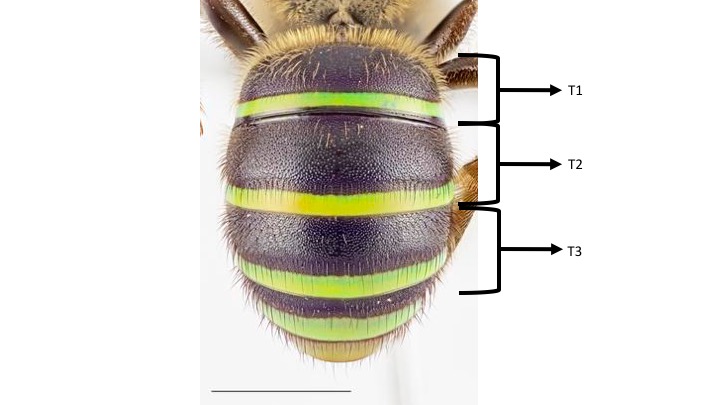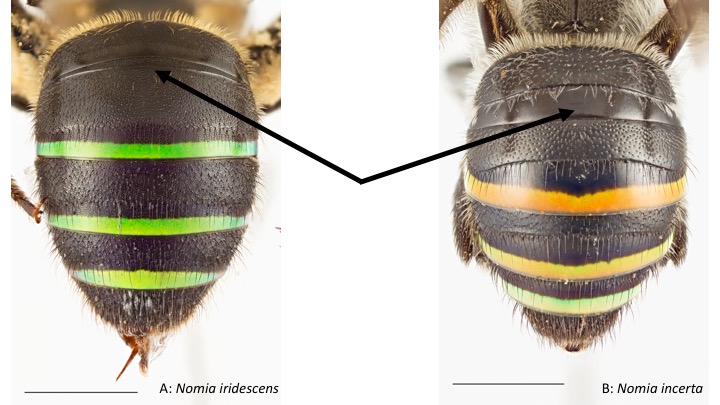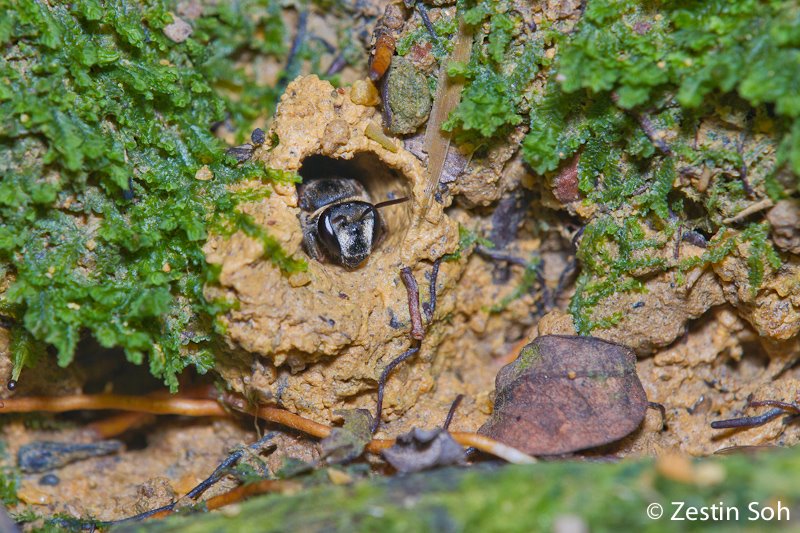
Figure 1. Nomia strigata seen visiting the native flower Melastoma malabathricum. (Photo by: Zestin Soh, used with permission)
Overview
Table of Contents
Bees are often only associated with the honey they produce or the pain that ensues from their sting. Sadly they are commonly very misunderstood creatures that deserve a little more love and attention. Here are three myths debunked!
1. "All bees make honey."
 |
| Figure 2. Bees do more than just make honey! |
The honey we are familiar with sold in supermarkets, come from a single group of bees known as honeybees. The European honeybee (Apis mellifera) is the most common eusocial bee species in the Northern hemisphere due to its importance in pollination and honey production[1] . The local representative in this region is the Oriental honeybee (Apis cerana), which is easily the most common bee sighted in our parks and gardens, usually occurring in large colonies of over 20 to 30 individuals foraging on a flower resource. They are not harvested for their honey, but serve an important role in pollination ecology by transferring pollen from one flower to another while foraging.
2. "All bees live in hives."
Honeybees from the genus Apis are an example of advanced eusociality, living in large colonies with social class, multiple generations within a nest at the same time and division of labour. Other examples of bees with advanced eusociality are stingless bees (Tribe: Meliponini) and bumblebees (Genus: Bombus). Their nests can be constructed inside of large tree cavities or even hollow man made structure. Humans have exploited this by harvesting honey from bees living in man made hives. On the contrary, carpenter (Genus: Xylocopa) and leaf cutter bees (Family: Megachilidae) live solitary lives where they forage alone and build nests in materials like soil and wood.
3. "Bees are scary and they sting!"
Firstly, most bees do not pose any serious harm to us humans even if they sting us. Although some are capable of stinging multiple times since their sting is barbless (unlike worker honeybees that have a barb in their sting that gets dislodged in the victim's skin, killing the bee after it stings). A group of bees known as the stingless bees (Tribe: Meliponini) have all lost their ability to sting. Next, since the sting is actually a modified ovipositor, only females are capable of stinging when threatened. As such, bees should not be feared but definitely approached with caution!
1. General introduction
Bees, together with waps and ants collectively form an order Hymenoptera within the class Insecta, with over 150,000 described species, making it the fourth largest insect order after Coleoptera (beetles and weevils), Lepidoptera (butterflies and moths) and Diptera (flies). Just like all insects, bees have a three segmented body plan with all six legs and paired wings located on their thorax (Fig. 3). Flies only have one pair of membranous wings, with the second pair of hind wings modified to become halteres. Bees on the other hand have two paired wings, both being membranous.

Figure 3. Top down view of a worker honeybee illustrating its three-segment body plan with arrows pointing to the antenna, wing and leg. (Photo by: Douglas Schenider, Stock Art; Annotations by: Angeline Teo).
Most wasps can be distinguished from their bee and ants counterparts by the presence of a double waist, a narrow constriction between the first two segments of the abdomen. Unlike bees that tend to have hair found on its face, body and legs, wasps usually lack hair and have a more shiny appearance. Both bees and wasps have permanent wings but ants only develop wings during the reproductive stage of their life cycle.
1.1 Sweat bees (Family: Halictidae)
Halictid or sweat bees make up one of the six extant bee families. There are 3,500 described species of halictid bees[2] . Their name 'sweat bee' is derived from the belief that these bees are attracted to our perspiration to fulfil their salt intake requirements although this has not been proven to be true. Locally, Halictidae is the second most commonly recorded bee family, right after Apidae [3] . They can be distinguished from other bees by observing for a strongly curved basal vein on their forewing (Fig. 4). Halictid bees are also seen to have more widely spread out hindlegs as compared to other bees.Figure 4. An example of a halictid wing veination. The arrow points to the strongly curved basal vein that separates halictid from other bee families. (Photo by: Katie Buckley, University of Florida, used with permission)
1.2 Habitat and Distribution
Halictid bee species are cosmopolitan in their range distribution. They can be found on every continent where bees are found. However the species Nomia strigata is restricted to Asia, mostly concentrated in Southeast Asia, not extending beyond Wallace's line (Fig. 5). Locally, Nomia strigata has been well sampled and represented across most parts of Singapore except in the East where the absence of bees might be due to the lack of sampling efforts (Fig. 6). Being a more tolerant and widespread species, their range is not limited to forested areas. They can be commonly found in disturbed and non-forested habitats such as parks and gardens that have some degree of urbanization. Out of the 14 species of Nomiinae bees recorded in Singapore, 11 of them can be found in urban landscapes, outside of forested areas [4] . While Nomia strigata is an example of a bee not restricted to forested areas, the same is not the same for a few others species that are less tolerant of disturbance and higher levels of urbanization. Within the subfamily Nomiinae, Nomia lusoria has been recorded to be mangrove associated while Nomia terminata is forest associated.Many factors influence the presence of bees. Such as the availability of a suitable flower patch, proximity to a forest patch and the provision of nesting resources. The factors that determine the presence of bee is likely to be inter-dependent and wide ranged.
Figure 5. Global distribution of Nomia strigata restricted to Asia and mostly concentrated in Southeast Asia. (Image from Discover Life)
Figure 6. Local distribution of Nomia strigata based on records from the NUS Insect Lab.
2. Morphology
2.1 Diagnostic characteristics
Nomia strigata appears blue green in flight due to its apical intertegumental coloured bands on its abdomen that have an iridescent colouration (Fig. 7). In their adult form, they are small to medium sized, with a generally black body including its legs and is well-furred especially on its face and thorax. The males and females do not display any obvious sexual dimorphism.
Figure 7. Side view of a dry mounted specimen of Nomia strigata (female) showing the intertegumental coloured bands on its abdomen. (Photo by: Chui Shao Xiong, used with permission)
To diagnose Nomia strigata, on the abdomen of the bee, T1 has as an apical coloured band that is similar in width to more distal bands and are all equally conspicuous (Fig. 8).

Figure 8. Abdomen of Nomia strigata showing the equally spaced out and conspicuous coloured bands on its abdomen. (Photo by: Chui Shao Xiong with annoations by Angeline Teo)
Next, T1 has punctures that are relatively dense, fine, irregular and of one size. In contrast, T2 and T3 has punctures of basal areas that are double-punctate, i.e. with punctures of clearly different sizes (Fig. 9)[5] .

Figure 9. Diagram illustrating diagnostic feature of Nomia strigata where T1 has punctures of a single size while T2 when viewed under high magnification, has double punctures of different sizes on the basal area. (Photo by: Chui Shao Xiong with annotations by Angeline Teo)
2.2 Comparing bees within genus Nomia
The most similar looking bees to Nomia strigata are Nomia iridescens and Nomia incerta. All three bees have the distinctive coloured intertegumental bands found on at least T2 to T4. However, on closer inspection, N. iridescens and N. incerta are both missing the coloured band on T1 as indicated by the arrows in Fig. 10.Nomia lusoria is the next most similar looking bee to Nomia strigata. Although it has the same distinctive coloured intertegumental bands from T1 to T4, the bands appear thinner than in Nomia strigata. Also, in the males, their hind leg is apically swollen as seen in Fig. 11.

Figure 10. Diagram of A: Nomia iridescens (female) and B: Nomia incerta (female) with arrows pointing to the missing first coloured intertegumental band on T1. (Photos by: Chui Shao Xiong with annotations by Angeline Teo)

Figure 11. Side view of Nomia lusoria (male) with arrows pointing towards the thinner intertegumental bands and the apically swollen hind leg that distinguishes it from Nomia strigata. (Photo by: Chui Shao Xiong with annotations by Angeline Teo)
3. Biology
3.1 Foraging
Bees within the subfamily Nomiinae, especially in Southeast Asia are not well studied but has been reported about the Oriental species but it is understood that Nomiinae bees are all solitary. They are also polylectic, seen to be collecting pollen from a variety of flowers, not restricted to a single family [6] . They employ a trap-lining feeding strategy that involves the bee visiting a flower patch in a regular and repeatable sequence[7] . This behaviour is also observed in butterflies, hummingbirds and mammals such as the capuchins. Although they are observed to collect and transfer pollen from one flower to another, their effectiveness as pollinators is not fully understood due to the lack of studies on its ecology. A study on a single species of flower Melastoma malabathricum, has been shown to deter Nomia strigata from visiting its flowers by recruiting weaver ants using attractants. Due to its small body size, Nomia strigata is considered to be an ineffective pollinator for this species of plant and so deterring visits would improve its own reproductive success[8] . Despite this, Nomia strigata has still been recorded visiting the flower Melastoma malabathricum in Singapore frequently.

Figure 13. Nomia strigata visiting a wildflower in Lamma Island, Hong Kong. Its intertegumental bands can appear blue due to its iridescent colouration. (Photo by: Sunnetchan)
Nomia bees are observed to use sonication or buzz pollination when foraging to collect pollen from certain flowers (Video 1). This is required of some flowers where pollen is held more tightly to the anthers as compared to other flowers where pollen brushes onto insects readily. Sonication restricts pollen collection to a subset of bees that are able to move their flight muscles rapidly in order to create vibrations that can forcibly expel the pollen from the anthers [9] . Honeybees for instance, are not able to perform sonication, while solitary carpenter bees are famous for buzzing loudly while foraging.
Video 1. Video with sound showing Nomia strigata collecting pollen from Ardisia elliptica using sonication, in Singapore Botanic Gardens, Singapore. (Video by: Zestin Soh, used with permission)
3.2 Nesting Behaviour and Reproduction
In terms of sociality, Halictidae bees are most diverse where species range from being solitary, communal, semi-social or eusocial [10] . Solitary bees live and build nests alone. However, some solitary bees are gregarious. Large numbers of bees of the same species can be seen nesting close to each other forming aggregations. In some species, multple bees might share a single nest but each bee constructs and provides for their cells individually. This behaviour is known as communal living. Social bees on the other hand live together in a nest and depending on the level of sociality. Eusocial bees live in colonies where there is a queen (mother) and her workers (daughter).Nomia strigata is a solitary, ground nesting bee and thus leaves its nest unprotected when it forages. It nests in the ground and in the soil by digging burrows underground to lay its eggs before the larvae develops and emerge from underground. It has been locally recorded to be able to nest in the moist soils of parks like MacRitchie Park, an urban park found in close proximity to a larger forest patch (Fig. 14).
The better known species of Nomiinae bee in the New World (Nomia melanderi), is well known to be solitary. The rest of the Nomia bee species however have not been well studied on their social and nesting behaviour. Although Nomiinae bee nest entrances are found to be not as constricted as that of most Halictidae bee nests, which are found to be as narrow as the bee's head [11] (Fig. 15). The study of Nomiinae nesting behaviour and architecture is very much fragmentary and needs more work.

Figure 14. Nomia strigata seen returning to its nest at the end of the day with arrow pointing to nest entrance. (Photo by: Zestin Soh, used with permission; with annotation by Angeline Teo)

Figure 15. Nest of Nomiinae bees (Nomia strigata) are observed to have a less constricted entrance as compared to other Halictidae bees. (Photo by: Zestin Soh, used with permission)
4. Conservation
4.1 Status in Singapore
Nomia strigata is well adapted to living in urban, non forested areas as long as bare soil is available for nesting nearby. A few other species that have done the same, might not be indigenous to Singapore but have simply expanded their habitat range beyond the forest [12] . The same cannot be said for other Halictidae species that have their habitats restricted to specific vegetations such as forests and mangroves. Since pristine patches of forests in Singapore are sparse, small and often fragmented, it reduces the quality and quantity of their range. Such species are rare and cannot be found outside their required habitats. The rare occurrence of species like Nomia elegans and Nomia apicalis might be a call for concern and need to prioritize the protection of our remaining forest habitats.4.2 Global threats
There are currently no global threats to the species Nomia strigata and its population remains well represented even in areas that are highly urbanized and with sparse forest cover.5. Taxonomy and Phylogeny
5.1 Taxonomic hierarchy
Kingdom: AnimaliaPhylum: Arthropoda
Class: Insecta
Order: Hymenoptera
Superfamily: Apoidea
Family: Halictidae
Subfamily: Nomiinae
Genus: Nomia (Latreille, 1804)
Subgenus: Acunomia
Species: Nomia (Acunomia) strigata (Fabricius, 1793)
In 1793, J. C. Fabricius decribed the species Nomia strigata alongside with many other animals mostly insects in his publication. However, the exact description of Nomia strigata itself is not found in the book. Records of its type specimen is also not found in any online databases. The lack of information about the taxonomic description and history of this bee makes it hard to track it back to its original description.
5.2 Phylogeny of Nomiinae bees
According to Alexander and Michener[13] , the conclusion from their analyses was that the family Halictidae is consistently monophyletic, supported by five synapomorphies (Fig. 16). Although the subfamily Nomiinae appears in different locations with multiple analyses, its two exemplar genera groups appear as sister groups consistently and so the subfamily Nomiinae is thus considered to be monophyletic.After revision using 109 adult character traits of 48 genera to construct a maximum parsimonious tree, Pesenko [14] concludes that the three subfamilies Rophitinae, Nomiinae and Halictinae are strictly monophyletic, with synapomorphies of 7, 9. and 3 to support respectively. Rophitinae is also considered a sister group to Nomiinae and Halictinae combined.
Due to the lack of published phylogenetic analysis done on bees in Southeast Asia, the phylogenetic relationship of Nomia strigata with other bees of the same genus cannot be determined. As such, it can only be represented as a subfamily which makes it hard to determine the conservation value of individual species within.
Figure 16. Phylogeny tree of family Halictidae with numbered characteristics listed (not found on this page).
6. References
- ^ Aizen, M. A., & Harder, L. D. (2009). The global stock of domesticated honey bees is growing slower than agricultural demand for pollination. Current biology, 19(11), 915-918.
- ^ Michener, C. D. (2007). pp. 6-11, 23-29, 57-58, 319-412. The Bees of the World, 2nd Edition. The John Hopkins University Press, Baltimore, MD. 952 pp.
- ^ Soh, Z. W. W., & Ngiam, R. W. J. (2013). Flower-visiting bees and wasps in Singapore Parks (Insecta: Hymenoptera). Nature in Singapore, 6, 153-172.
- ^ Ascher, J. S., Chui, S. X., Soh, Z. W. W., Lee, J. X. Q., & Soh, E. J. Y. (2016). Bees of the subfamily Nomiinae (Halictidae) of Singapore. Unpublished manuscript.
- ^ Ascher, J. S. (2016). An annotated checklist of the bees (Hymenoptera: Apoidea: Anthophila) of Singapore. Unpublished manuscript.
- ^ Karunaratne, W. A. I. P., Edirisinghe, J. P., & Gunatilleke, C. S. (2005). Floral relationships of bees in selected areas of Sri Lanka. Ceylon Journal of Science, 34, 27-45.
- ^ Type the content of your reference here.
- ^ Gonzálvez, F. G., Santamaría, L., Corlett, R. T., & Rodríguez‐Gironés, M. A. (2013). Flowers attract weaver ants that deter less effective pollinators.Journal of Ecology, 101(1), 78-85.
- ^ Kearns, C. A., & Inouye, D. W. (1997). Pollinators, flowering plants, and conservation biology. Bioscience, 47(5), 297-307.
- ^ Michener, C. D. (2007). pp. 6-11, 23-29, 57-58, 319-412. The Bees of the World, 2nd Edition. The John Hopkins University Press, Baltimore, MD. 952 pp.
- ^ Wcislo, W. T., & Engel, M. S. (1996). Social behavior and nest architecture of nomiine bees (Hymenoptera: Halictidae; Nomiinae). Journal of the Kansas entomological Society, 158-167.
- ^ Ascher, J. S., Chui, S. X., Soh, Z. W. W., Lee, J. X. Q., & Soh, E. J. Y. (2016). Bees of the subfamily Nomiinae (Halictidae) of Singapore. Unpublished manuscript.
- ^ Alexander, B. A., & Muchener, C. D. (1995). Phylogenetic studies of the families of short-tongued bees (Hymenoptera: Apoidea). The Univ. of Kansas science bull, 55(11).
- ^ Pesenko, Y. A. (1999). Phylogeny and classification of the family Halictidae revised (Hymenoptera: Apoidea). Journal of the Kansas Entomological Society, 104-123.


